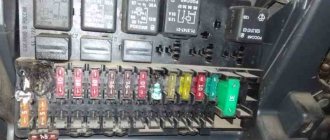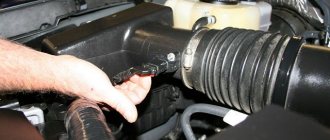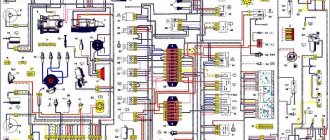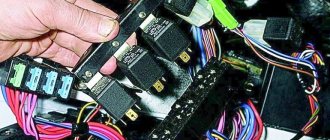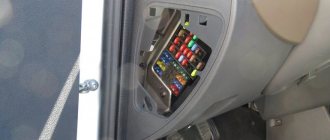:diablo:The 25A heater fuse started to burn at speed 3-4, and if it doesn’t burn, it smells like burning at both speed 1 and 2. No matter how the fuse box burns out, they say that by changing the fan motor the problem will resolve itself, they say that the resistor needs to be changed, but in fact, who knows the real cause of this malfunction!
I know. Warranty case. Problems in the motor, current consumption at speed 4 is maximum, voltage goes directly to the fan motor.
The resistor is burning! Panas! This is their sore spot! The whole stove is changing!
So it seems included. There is no resistor with the air conditioner. There's also RHF. The author should at least write what kind of equipment it is.
But the heater motor won’t just fall out either! Only if something hits it and jams it?
There were many threads with a similar problem. The result is replacement of the engine under warranty. For example here: https://www.priorovod.ru/showthread.php?t=18333
There were many threads with a similar problem. The result is replacement of the engine under warranty. For example here: https://www.priorovod.ru/showthread.php?t=18333
I had the same story, but mine was on at speed 4 and most likely some kind of nasty stuff got on the manifold because before that it smelled like burning and there was nowhere else for it to come from)))) By the way, it went away by itself and now it works ..probably dirt flew out
I see (((.What are you saying that needs to be taken apart and lubricated? Is this serious? I’m not into electrics at all boom boom boom)))
If it's under warranty, let the craftsmen rack their brains. This is a warranty case
Yes, the motor slows down and spins up slowly
So it can lubricate it.
I turned the airflow to three and it died. Before this, the cooling fan was working. What could be the problem? Maybe the fuses, I don’t want to go to the service center, you can replace them yourself.
Search rules https://www.priorovod.ru/search.php
I turned the airflow to three and it died. Before this, the cooling fan was working. What could be the problem? Maybe the fuses, I don’t want to go to the service center, you can replace them yourself.
Have you tried to look at the ships? https://www.priorovod.ru/showthread.php?t=18985
Djoni, No offense, but the electrician I know is probably a bit weak in electrical engineering. If the resistor had burned out or its thermal compensation resistance would not have been at 1, 2 and 3 speeds of rotation of the electric motor. If the fuse burns at 4 speeds, the current consumption of the motor exceeds the fuse rating. The main reason is the jamming of the electric motor shaft in the bushings. It can be treated by disassembling and lubricating, as well as replacing with a new one. This problem also occurred in the 10s.
Is this a warranty case? Will this affect anything later? I mean, if I don’t use speed 4 on the other 3 speeds, it won’t have any effect? If you install a stronger fuse, what are the consequences?
How does a car fuse work?
One of the simplest structural elements of a car is a fuse, which consists of two main parts - a plastic body and a fuse-link with contacts. However, despite the simplicity of the design, such details play a very important role. After all, they not only eliminate the possibility of electrical equipment failure, but also prevent the possibility of a fire. It is thanks to fuses that when a short circuit occurs in the electrical circuit or under increased load, the insulation on the wires does not melt, but the fuse-link burns out.
Priora uses flag or plug-type devices. Inside the case there is a plastic insert that has a certain current rating. The fuse housing has a transparent appearance, which is done specifically to visually determine the suitability of the product. Legs protrude from the body - they are also contacts that close the electrical circuit.
The main parameter of fuses is the current strength. The corresponding value for which the element, or more precisely, the fuse link, is designed is indicated on the body. If there is no designation, then you should focus on the color of the case. The case is painted in different colors for a reason, but in order to determine whether a particular fuse belongs to the corresponding current rating. Below is a photo showing the colors and their corresponding current ratings.
Use this information if you find it difficult to determine the fuse rating yourself. Having understood the device and color rating, you should consider the principle of operation of the devices.
In the circuits of various electrical equipment, fuses are installed that have a certain current rating. Electrical appliances consume different currents, and to eliminate the possibility of false operation, devices with the appropriate current rating are used. When a large current begins to flow in the circuit, the wires heat up, but the first thing that heats up is the fuse-link, which is eventually interrupted, thereby breaking the circuit.
The absence of a fuse would in such a situation lead to melting of the insulation, and as a result, shorting of the positive contacts to ground. The result of such consequences is disastrous for the vehicle, as can be seen by looking at the photo below.
Such consequences arise when fuses are installed of the wrong rating or drivers completely neglect the need to use such devices, and in the event of a melted fuse insert, they solve this problem by short-circuiting the circuit with jumpers. This cannot be done, since the result of such rash actions leads in 100% of cases to dire consequences.
Fuses cannot be repaired. There is no need to try to solder the fuse links, thereby restoring the functionality of the products. If the device fails (more precisely, it worked), then it is not suitable for use and must be replaced. Moreover, it is important to install fuses of a similar current rating in the circuit, since neglecting this rule will lead to the following consequences:
- if the fuse is installed with a lower rating than necessary, it will trip more often even for no apparent reason;
- If the product is installed with a higher rating than necessary, then with an increased load in the circuit, the fuse-link will not operate in a timely manner, and the insulation will melt. Every driver understands the outcome and consequences of insulation melting.
Having understood the design of fuses, their operating principle and differences in rating, we move on to considering the devices on the Lada Priora car. Let's consider all possible configuration options for the Priora, indicating all the fuses and relays.
Subtleties of replacement
When replacing protective parts, some car owners choose an element with a lower or higher rating. Doing this is strictly prohibited. It is necessary to choose a similar element so that there are no problems with the car in the future. Another mandatory and important point is to disconnect the terminal with the “+” sign from the battery.
The fuse located on the side can be removed without the use of any tools. It is easily pulled out with your fingers; it is enough to overcome the resistance created by the spring-loaded contacts. But the elements that are located between other fuses cannot be easily reached. Special tweezers are provided for these purposes. It is located right there, in the block, on the right side. After replacing the faulty element with a working one, you can connect the terminal and check the functionality of the stove. All that remains is to install the protective cover and turn the locking locks.
None of us are immune from breakdowns on the road. It’s clear that no one carries a set of spare elements with them. There is a way out of this situation, but it can only be used in extreme cases, when you just need to get to the nearest populated area to buy a replacement for the faulty element. You will need copper wire, which must be wrapped around the contacts of the fuse link. Such repairs are only temporary and should only be used as a last resort.
We tried to answer all the questions related to replacing the heater fuse in the Lada Priora. Follow the advice provided, be careful and do not put off repairing your car.
Where are the fuse and relay blocks located on the Priora?
Before you start checking the fuses, you need to understand their location. On a Priora car, blocks with fuses and relays are located in several places, and therefore we will consider where to look for them.
- Engine compartment - there are two blocks here. The first (main) fuse block (without relay) is responsible for the health of the power circuits of devices such as the ECU, cooling fan, generator, EMUR or EUR and others. The photo below shows what this block looks like. It is located under the hood next to the battery.
To find it under the hood, you need to look in the area of the left “glass”. Its location is shown in the photo below. - The engine compartment is a fuse and relay box responsible for protecting the air conditioning system. Naturally, such units are available on Priors, which have an air conditioning system. This block is located near the left “glass” and consists of fuses and control relays. It is important to note that the units differ depending on the type of air conditioning system used on the vehicle. Prioras are equipped with air conditioners of two brands, Halla and Panasonic, and depending on the type, the units differ in the internal arrangement of the elements. The photo below shows where the fuse box and relay for the air conditioning system are located on a Priora.
- The car interior - there are also two fuse and relay blocks installed here. The first is located directly under the dashboard on the driver's side. This block contains fuses that are responsible for the electrical equipment on the car, namely, light, sound signal, cigarette lighter, immobilizer, double-glazed windows, etc. The photo below shows where this block is located.
- Inside the car under the center console on the passenger side. Few people know about this fuse and relay block. This block contains fuses that are responsible for the health of the fuel pump, ECU and starter circuits. The relays on this block are responsible for switching the ignition switch and fuel pump circuits. Below is a photo of where this block is located on Priora.
Knowing the places where the fuses and relays are located on the Priora, you can begin to consider the purpose of each element.
This is interesting! Depending on the configuration of the Priora, the fuse and relay blocks, which are located under the dashboard on the driver's side, differ.
Possible reasons
If the fuse blows, this means the overload protection has tripped. It’s worse if it’s intact and the conductors get hot. There can only be one reason for such a deviation in the operation of the fuse links - they set a higher rating than indicated in the electrical diagram.
The fuse blows due to a lower rating. All protective elements should be checked. Often car manufacturers indicate these values near the installation location or on the plastic cover of the electrical unit.
In the latest cars, if a fuse blows, an error number is displayed on the on-board computer monitor. Using the manual, you can quickly determine the installation location of the faulty element. The unit is installed in the cabin for easy replacement of failed fuses.
Often it is enough to replace the burnt out element, but if the fuse constantly blows, this requires finding and eliminating the cause. Current leakage is the main problem in used cars. This situation occurs when the wiring is heavily worn.
Main fuse box on Priora under the hood: purpose of elements
First, let's examine the fuse box, which is located under the hood of the Priora. The unit is equipped with high-rated fuses, which indicates protection of the power circuits of powerful electrical equipment.
This is interesting! For easier searching, use the Ctrl+F key combination on your computer.
Below is a photo of the block with the corresponding name of the fuses.
- The first 30A green F1 is responsible for protecting the power circuit of the electronic computer system, the fuel pump and the ignition relay.
- The second F2 60A blue color is designed to protect the power circuit of the electric fan of the cooling system, as well as the ignition relay, heated rear window and the double-glazed window controller.
- The third 60A blue F3 is responsible for protecting the cooling fan power supply control circuit, as well as the horn, hazard warning lights, ignition switch, instrument cluster, interior lighting, STOP signal and cigarette lighter.
- The fourth F4 60A blue is designed to protect the generator circuit.
- The fifth F5 50A red color is designed to protect the power circuit of the electromechanical power steering EMUR.
- The sixth F6 60A blue is designed to protect the generator circuit.
To check the suitability of these fuses, they do not have to be removed from the block. To do this, there are open contacts on the front part through which you can ring the elements and make sure that the fuse link is in good condition.
Problems in the cooling system
The radiator cooling fan consumes high currents; the slightest contamination increases the values by more than 20% of the nominal ones. This is enough to heat up and subsequently blow the fuse. But more often this happens at the moment of startup.
The simultaneous activation of several powerful consumers on used cars often leads to the cooling fan fuse blowing. The VAZ 2107 is equipped with a limited power generator with voltage stabilization using one stabilizer. If the latter fails and produces excessive values, there will be an overload in the system and the first loaded fuse element will burn out.
Fuse box in the interior of a Priora car: basic configuration (standard) without air conditioning
Now let's look at the main fuse and relay block for electrical equipment, which is located inside the car under the dashboard on the driver's side. The photo below shows where the block is located.
To gain access to it, you need to unscrew the three thumbs and remove the plastic decorative trim.
After this we will see the corresponding fuse and relay block of the Priora. Its appearance will vary depending on the type. They come in two versions:
- type 1118-3722010-00;
- DELRHI 15493150.
The difference between them is insignificant, as you can see by looking at the photo above.
Next, we will consider the location and purpose of each fuse in the standard configuration of a Priora car. Below is an example on a mounting block type 1118-3722010-00.
And accordingly the designation of these fuses.
- F1 - 25A - Electric radiator fan of the engine cooling system.
- F2 - 25A - Heated rear window.
- F3 - 10A - High beam lamp (right side).
- F4 - 10A - High beam lamp (left side).
- F5 - 10A - Sound signal.
- F6 - 7.5A - Low beam lamp (left side).
- F7 - 7.5A - Low beam lamp (right side).
- F8 - 10A - Signal.
- F9 - 25A - Heater fan.
- F10 - 7.5A - Instrument cluster contact “30”. Interior lighting and STOP signal lamps.
- F11 - 20A - Windshield wiper (wipers) and heated rear window (control).
- F12 - 10A - Output “15” on the instrument panel.
- F13 - 15A - Cigarette lighter.
- F14 -5A - Side lights (left side).
- F15 - 5A - Side lights (right side).
- F16 -10A - Output “15” to the ABS system.
- F17 - 10A - Fog lamp (left side).
- F18 - 10A - Fog lamp (right side).
- F19 - 15A - Heated seats.
- F20 - 5A - Control unit.
- F21 - 7.5A - Rear fog light.
- F22-F30 - Reserve.
- F31 - 30A - Electrical window control unit.
- F32 - Reserved
Below is a photo from the manual.
Now let's define the relay designations. The photo below shows their numbering.
The relays on the Priora in the standard configuration without air conditioning have the following purposes:
Having familiarized ourselves with the basic configuration (standard) of the Priora, we move on to studying the VAZ-2170 car in the Luxury configuration.
Heating system problem
If the VAZ-2107 heater fan fuse blows, then you should first look for the reasons in the engine itself. The impeller often becomes clogged with dust and pieces of dry leaves. An inspection of the rotating elements will not hurt.
Check the voltage supply contacts. They must be insulated and securely fastened. The engine cannot run if moisture gets inside. There is a gap between the rotating elements, in which there should be no foreign inclusions. Although it is sealed, under certain conditions moisture can get in.
The fuse may blow due to a faulty control circuit. It is worth checking the heater motor relay, connections to it, and the integrity of the tracks on the circuit board. If a malfunction is suspected, the element should be replaced; its cost is low compared to the price of the engine.
Fuse and relay block on Priora Lux and Lux Plus: designations and assignments
The fuse and relay block on the Priora in the Lux and Lux Plus configurations looks like this, as shown in the photo below.
The photo below shows how to correctly count fuses.
The fuses are indicated above, how to correctly read them on the block. They have the following designations:
- F1 - Reserve socket.
- F2 - 25A - Heated rear window, electrical package module, relay and connector “10” of block XP2 for connecting the rear window heater.
- F3 -10A - Right headlight, high beam lamp, instrument cluster, signal lamp for turning on the high beam headlights.
- F4 - 10A - Left headlight high beam lamp.
- F5 - 10A - Mounting block (protection), horn relay and horn.
- F6 - 7.5A - Left headlight low beam lamp.
- F7 - 7.5A - Low beam lamp of the right headlight.
- F8 - 10A - Mounting block, anti-theft alarm relay and anti-theft alarm sound signal.
- F9 - Reserve socket.
- F10 - 10A - Instrument cluster, contact “20”. STOP signal switch and STOP signal lamp. Interior lighting unit and interior lighting. The door sill light on the right front door. Auxiliary STOP signal.
- F11 - 20A - Mounting block, high-speed windshield wiper relay. Switch for cleaners and washers, contact “53a”. Wiper and washer switch, contact “53ah”. Heated rear window switch. Mounting block, rear window heating relay (winding). Windshield wiper motor. Rear window wiper motor (for 2171, 2172). Windshield washer motor. Rear window washer motor (for 2171, 2172). Airbag control unit, pin "25".
- F12 - 10A - Instrument cluster, contact “21”. Electrical package controller, contact “9” of block X2. EMUR control unit (EUR), contact “1” of block X2. Reversing lamp switch. Parking system control unit, contacts “11” and “14”.
- F13 - 15A - Cigarette lighter.
- F14 - 5A - Dimensions lamps (left side). Instrument cluster, light on indicator. License plate lights and trunk light. Electrical package controller, contact “12” of block X2.
- F15 - 5A - Dimensions lamps (right side). Lamp for lighting the glove compartment.
- F16 - 10A - Hydraulic unit of the ABS system, contact “18”.
- F17 - 10A - Left side fog lamp.
- F18 - 10A - Fog lamp right side.
- F19 - 15A - Seat heating switch, contact "1". Front seat heater.
- F20 - 10A - Recirculation switch (on indicator). Mounting block, relay for low beam headlights and parking lights (automatic lighting control system). Heater electric fan relay. Automatic lighting control switch. Windshield wiper and external lighting control unit, contacts “3” and “11”. Climate system control controller, contact "1". Automatic window cleaning system sensor (rain sensor), contact “1”.
- F21 - 5A - Light signaling switch, contact "30". Diagnostic block, contact “16”. Clock and climate control controller, pin “14”.
- F22 - 20A - Windshield wiper motor (automatic mode). Mounting block, windshield wiper relay and high speed windshield wiper relay.
- F23 - 7.5A - Control unit for windshield wipers and external lighting, contact “20”.
- F24-F30 - Reserve socket.
- F31 - 30A - Electrical package controller, terminal “2” of block X1. Electrical package controller, terminal “3” of block X1. Double-glazed window control module on the driver's door, pin “6”. Lamp light for the threshold of the left front door.
- F32(F28) - 40A - Reserve on Priora without ABS. On a Priora with ABS: ABS system unit.
And a similar table in the form of a photo, which can be printed on a printer if necessary.
Below is a pinout diagram for the central unit of the body electronics.
Now about the actual purpose of the relay on the mounting block. Below is a photo with the relay designation.
All these relays have the following purposes:
Below is a wiring diagram of the mounting block for Priora Lux Plus.
This is interesting! When replacing fuses, buy products not only of the appropriate rating, but also from reliable manufacturers. It is not recommended to buy Chinese-made products that are not tested. For Priora, it is recommended to choose fuses of the LittelFuse brand.
Lighting
If the headlight fuse blows, this indicates a short circuit in the lighting circuit. Lamps may not be the same wattage after replacement. Rarely, there are cases when a short circuit occurs inside a glass flask. Although an external check shows that the electrodes are connected.
Such a lamp must be replaced and the operation of the circuit checked without it. The fuses may be defective and rated for a different current. It is worth buying elements from trusted brands in the departments of auto stores.
Violation of the tightness of the headlight leads to moisture accumulating in the socket where the lamp is installed. This can be determined by the fogging of the glass from the inside in the morning or late evening. This headlight must be replaced; on new cars this can be done under warranty.
Relays and fuses for Panasonic and Halla air conditioners on Priora: purpose of elements
If the Priora has an air conditioning system installed, then the mounting block, consisting of fuses and relays, is responsible for switching and protecting the circuit. This block is located in the engine compartment. It was already mentioned above that depending on the air conditioner model, the arrangement of the elements differs. In order not to get confused, we will consider separately the purpose of fuses and relays for both types of Priora air conditioning systems.
The Panasonic air conditioning system mounting block looks like this, as shown in the photo below.
They are responsible for protecting and switching the following circuits:
- K1 - turning on the air conditioner radiator cooling fan at maximum speed.
- K2 - right cooling fan.
- K3 - sequential activation of fans at low speed.
- K4 - right cooling fan.
- K5 - heater fan.
- K6 - compressor.
- F1 (30A) - left fan at low speed.
- F2 (30A) - right fan.
- F3 (40A) - heater fan.
- F4 (15A) - compressor.
If the fans malfunction, first check the fuses and relays in the mounting block of the air conditioning system.
The installation block of the Halla air conditioning system on the Priora has minor differences. The photo below shows what it looks like with the elements labeled.
They have the following purpose:
- F1 (30A) - fuse for the right fan power supply circuit.
- F2 (30A) - left fan power supply fuse.
- F3 (40A) - heater fan power fuse.
- F4 (15A) - compressor power fuse.
- K1 - right fan relay.
- K2 - additional relay for turning on the right and left fans.
- K3 - left fan relay.
- K4 - heater fan relay.
- K5 - compressor relay.
Knowing the location of the corresponding fuses and relays, it will not be difficult to check the electrical circuit and detect malfunctions.
Domestic cars
The “classics” of the automotive industry, series 2106, 2107, 2103, had many weak points in electrical equipment. Connections weaken over many years of use, and motors change conductivity. Vibrations and moisture cause leakage currents to the housing, and the distribution of potentials changes.
A common problem with “classics” is the formation of oxides on the contacts. However, this situation leads to an additional voltage drop; the fuse is unlikely to blow. More likely, it will fail due to poor contact.
Negative operating modes of fuses create problems when troubleshooting. This is possible when the currents exceed the rated ones slightly. The fusible element is constantly heated to a temperature that is not sufficient for its combustion.
An introductory word about protective elements
Electrical circuits on Priora require protection, the functions of which are performed by fuses. These elements are equipped with fusible inserts. They are designed for a maximum current rating, which is different for each fuse. These protective elements are located in a special block on the left side of the driver, at the bottom of the instrument panel. The fuse for the Priora stove, as well as other protective elements, has a pin shape, inside of which there is a fuse-link. It is this insert that tends to burn out at the moment when the current exceeds the permissible value.
The structure of the electrical wiring diagram contains another protective element: a relay. They are installed on the most powerful current consumers. These include the rear window heating system, heater fan motor, engine cooling fan, and car horn. Such protective parts are also placed in a common block. Priora heater relays are necessary to reduce the current load that is applied to the switch contacts. With such a protection system, contact pairs do not burn out.
In case of malfunctions with the heater, you must also pay attention to the relay. Now that we have found out where the Priora stove fuse is located, we can move on and get acquainted with other aspects of replacing this important element.
conclusions
Priora has three mounting blocks with layout diagrams for fuses and relays - the main one and two additional ones. If the schemes are unchanged, then for the main one it changes depending on whether we are talking about standard or luxury trim levels. Knowing the location of certain elements, their designations and numbers allows you to speed up the diagnosis and solution of problems. Especially considering that some important relays are separated into different blocks - such as the fuel pump and starter.
Specialization: Graduated from the State Automobile University, worked for 20 years at GAZ-56, now I drive a Zhiguli.
Lada Priora fuses are responsible for the operation of all electrical devices in the car. Due to the so-called selectivity of their operation, in the event of a malfunction, only a certain section of the circuit is switched off. Understanding the purpose of a particular fuse link in a fuse block, you can significantly simplify the process of diagnosing and localizing a fault.
Lamp burned out
Naturally, if any light source does not turn on, the first thing that comes to mind is that the light bulb has burned out. The design of car lamps is such that the low beam may indeed be absent, but the high beam remains available. Halogen lamps have two filaments. It is quite possible for one of them to rupture - in this case, the light for which it is responsible will be absent.
To replace the bulb, the services of an auto electrician are not required. It is enough to open the hood with the ignition off, remove the protective box on both sides of the headlight, pull out the contact group, disconnect the spring clips, remove the burnt out bulb and install a new one.
A little subtlety:
The flask should be wiped with alcohol before installation, otherwise it will burn instantly. It is also not recommended to handle the bulb with unprotected hands: there is always some greasy and damp secretions on them, which can damage the light bulb. The best way to do this (replace the lighting) is with a dry cloth or rag.
Examination
First of all, the electrical circuit “rings” to the housing. In this case, the battery terminals are disconnected. It must be remembered that the second wire from the engine goes to the housing; it must have zero contact resistance. The supply conductor is checked for short circuit.
If the wiring is intact, proceed to checking the voltage of the electrical circuit assembly. Measuring points are determined according to the diagram in the car manual. Also, the power at the battery terminals must be at least 12 V when the engine is off. When operating, a value above 13.6 V is measured.
With a multimeter you can measure resistance, contact integrity, and check voltage. The presence of oxides or mechanical damage is determined visually.
